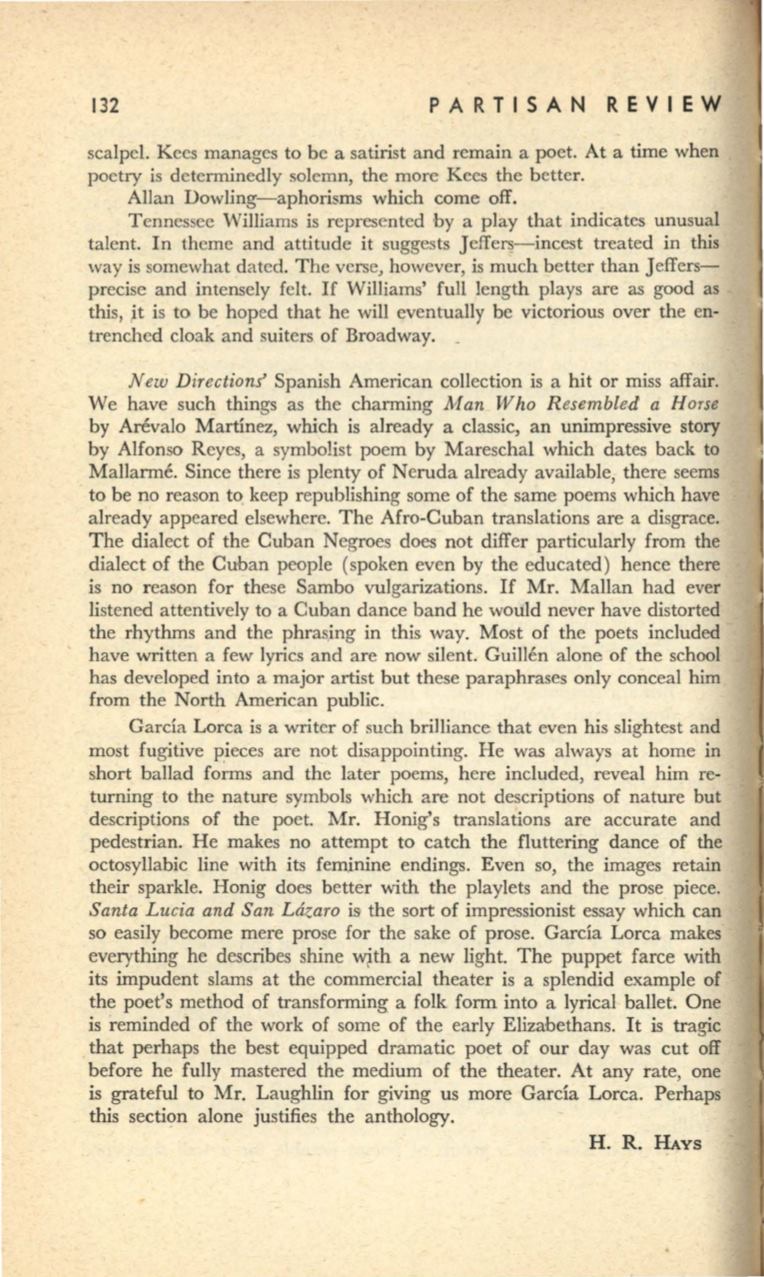
132
PARTISAN R EVIEW
scalpel. Kees manages to be a satirist and remain a poet. At a time when
poetry is determinedly solemn, the more Kees the better.
Allan Dowling-aphorisms which come off.
T ennessee Williams is represented by a play that indicates unusual
talent. In theme and attitude it suggests Jeffers-incest treated in this
way is somewhat dated. The verse, however, is much better than Jeffers–
precise and intensely felt.
If
Williams' full length plays are as good as
this,
jt
is to be hoped that he will eventually be victorious over the en–
trenched cloak and suiters of Broadway. _
New Directions'
Spanish American collection is a hit or miss affair.
We have such things as the charming
lvfan Who R esembled a Horse
by Arevalo Martinez, which is already a classic, an unimpressive story
by Alfonso Reyes, a symbolist poem by Mareschal which dates back to
Mallarme. Since there is plenty of Neruda already available, there seems
to be no reason to keep republishing some of the same poems which have
already appeared elsewhere. The Afro-Cuban translations are a disgrace.
The dialect of the Cuban Negroes does not differ particularly from the
dialect of the Cuban people (spoken even by the educated) hence there
is no reason for these Sambo vulgarizations.
If
Mr. Malian had ever
listened attentively to a Cuban dance band he would never have distorted
the rhythms and the phras,ing in this way. Most of the poets included
have written a few lyrics and are now silent. Guillen alone of the school
has developed into a major artist but these paraphrases only conceal him
from the North American public.
Garcia Lorca is a writer of such brilliance that even his slightest and
most fugitive pieces are not disappointing. He was always at home in
short ballad
fo~ms
and the later poems, here included, reveal him re–
turning to the nature symbols which are not descriptions of nature but
descriptions of the poet. Mr. Honig's translations are accurate and
pedestrian. He makes no attempt to catch the fluttering dance of the
octosyllabic line with its fem,inine endings. Even so, the images retain
their sparkle. Honig does better with the playlets and the prose piece.
Santa Lucia and San Laz;aro
is the sort of impressionist essay which can
so easily become mere prose for the sake of prose. Garcia Lorca makes
everything he describes shine w;ith a new light. The puppet farce with
its impudent slams at the commercial theater is a splendid example of
the poet's method of transforming a folk form into a lyrical ballet. One
is reminded of the work of some of the early Elizabethans. It is tragic
that perhaps the best equipped dramatic poet of our day was cut off
before he fully mastered the medium of the theater. At any rate, one
is
grateful to Mr. Laughlin for giving us more Garcia Lorca. Perhaps
this section alone justifies the anthology.
H. R.
HAYS


